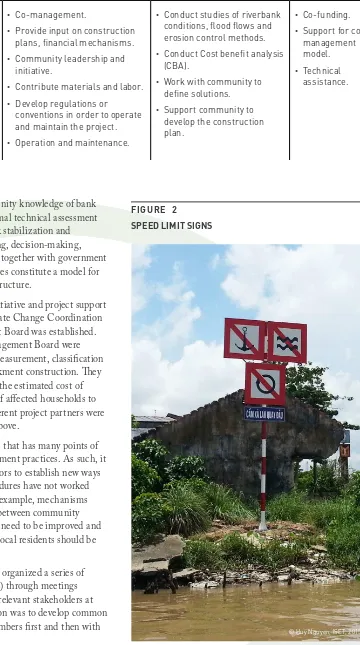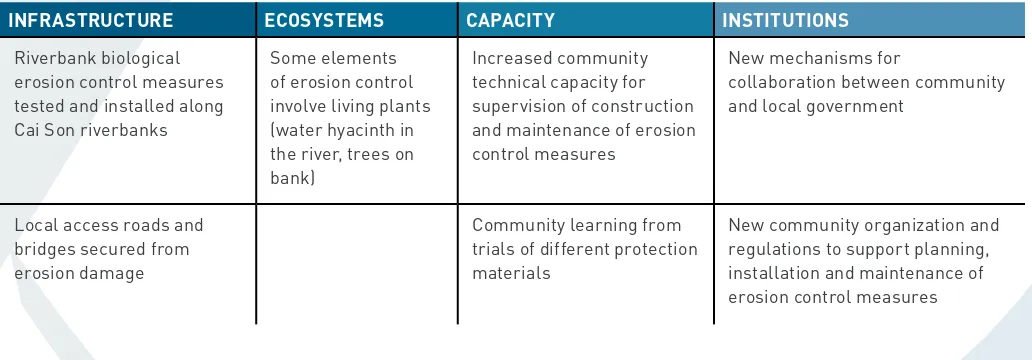India
Thailand
Can Tho
w w w. S - E-o r g
VIETNAM Project Lev
The problem
Urbanization along Can ho’s historical system of rivers and drainage channels has led to greater damage from riverbank erosion. Erosion risks are highest for households in traditional Mekong riverbank houses in peri-urban areas that are now experiencing rapid development. Each year, there are several major erosion incidents leading to deaths and property damage. he city is building concrete embankments but this is only afordable for high-value central areas. Peri-urban residents and businesses along river channels remain highly exposed to erosion.
Finding Solutions
he project developed new institutional mechanisms that combine community initiative and oversight with government technical and inancial support. he processes of community engagement, the mechanisms for joint planning and
management, and the biological erosion control techniques may all be replicable in other similar contexts in Mekong Delta communities.
In an experimental approach, the district level government, ward leaders and the local community collaborated to test low-cost bank stabilization measures. Innovations NSUE FOR SOCAL AND ENVRONMENAR ANSON-NERNAONAL
CL
MA
E RES
L
ENCE CASE S
UDY
C
ho, Vietn
CO-MANAGEMENT OF RIVERBANK EROSION CONTROL IN CAN THO
2013 –2016 | Implementing Partner: C ho Cimte Chnge Coordintion Ofice (CCCO C ho)
HE CON
EX
For more informtiobout our projecnd pubictions, pese visit: i-s-e-t.org/projects/c-tho-erosion.htm Pubished Apri0 1 6
© Chu Ky, CCCO Cho, 2 0 1 5
Cho is situted in the centre of the Mekong Det,
witopution o pproximtey 1 miion peope.
An Binh wrdensey-poputed midde tower
income residentiren the centr ho district
of Ninh Kieu, hs 1oc!ns wit"otength
o pproximtey 1 0 km. About 1 0 -1 5 yergo, these
dringe chnnes pyen importnt roe in community
ife; fciitting wterwy trnsporttion, providing wter
for domesti!ngricutur#send providing dringe
for residentires.
$n recent yers, during high-wter seson, tid%ooding
hs become more common in these cns. Commerci
shipping hso increseong the min cns in the
city&he combintion of these fctors hed to incresed
riverbnk erosionoss of bnk stbiitong the Ci
Son river in An Binh.
Some househodredy buid bmboo fences, grow
wter hycintnd pnt treeong the riverbnk to
reduce erosion. However, there hs been no ofici
support for thes'ctivities, no study of their comprtive
effectiveness, no technicdvice tocousehods to
improve prcticend no"ousehods cfford the
cost. As such, riverbnk protection is inconsisten"nd
ineffective&he sitution is compex. Some residents do
not hod tite to th'nd on which they hve buit, different
sections of the riverbnr't vrying degrees of risk
(esut of soind vegettion conditionnd in some
pces erosion thretens pubic infrstructure sucs
rodwys or utiity distribution systems, whie in others it
)SET-International | Climate Resilience Case Study
included the recognition of community knowledge of bank vulnerability and stabilization, formal technical assessment of Malaleuca cajuputi poles for bank stabilization and community involvement in planning, decision-making, construction and project oversight, together with government authorities. Together, these measures constitute a model for co-management of adaptive infrastructure.
In June 2014, as a result of local initiative and project support from ISET and the Can ho Climate Change Coordination Oice, a Community Management Board was established. Members of the Community Management Board were trained and took part in surveys, measurement, classiication and planning for biological embankment construction. hey discussed within their community the estimated cost of each measure and responsibilities of afected households to contribute resources. Roles of diferent project partners were deined as shown in the Figure 1 above.
Co-management is a new approach that has many points of contradiction with current management practices. As such, it has been challenging for all the actors to establish new ways of doing things. Some of the procedures have not worked well and need to be improved. For example, mechanisms to negotiate and manage conlicts between community beneits and private land use rights need to be improved and communication mechanisms with local residents should be strengthened.
To address these needs, the project organized a series of Shared Learning Dialogues (SLDs) through meetings between the local community and relevant stakeholders at ward and district level. he intention was to develop common agreements among community members irst and then with government.
FIGURE 1
ROLES OF STAKEHOLDERS AND COMMUNITY
FIGURE 2
SPEED LIMIT SIGNS
Local government Local community Scientists/Experts NGO and Donor
• Co- funding
• policy guidance.
• Co-monitoring and co- management.
• Negotiate with households as needed.
• Organizing, monitoring the construction.
• Materials management, asset and investment for the project.
• Co-management.
• Provide input on construction plans, inancial mechanisms.
• Community leadership and initiative.
• Contribute materials and labor.
• Develop regulations or
conventions in order to operate and maintain the project.
• Operation and maintenance.
• Conduct studies of riverbank conditions, lood lows and erosion control methods.
• Conduct Cost beneit analysis (CBA).
• Work with community to deine solutions.
• Support community to develop the construction plan.
• Co-funding.
• Support for co-management model.
• Technical assistance.
Co-management of riverbank erosion control in Can Tho | Vietnam 2016
Outcomes
he construction of the biological erosion control measures took only two months and was completed by September 30th 2014. he total length of biological embankment is 3,086 m along both sides of the riverbank, which is about twice the originally planned length. he length of riverbank protection was able to be increased due to lower than expected costs for the Malaleuca poles, and because of community contributions (980 person-days of labour and VND 170 million or roughly USD $7,700 in cash). he communities along both sides of Cai Son developed a collective regulation for riverbank management that was approved by An Binh ward. he key message shared with households in the community is “my riverbank, my responsibility”.
After two lood seasons in 2014 and 2015, there has been no erosion damage so local men and women are very happy with the results of the project in protecting their property and their shared access roads to the community.
A cost beneit analysis showed that at 10% discount rate, the net present value was estimated as VND 7.4 billion (roughly
USD $350,000), the internal rate of return was 60% and the beneit cost ratio of the project was 3.4. We conclude that the biological embankment project along the of Cai Son River brings signiicant economic beneits, primarily to riverbank residents. Some of these residents have low incomes and lack legal tenure, so the project also has distributional beneits.
In addition, the community successfully inluenced the city government to install speed limit signs for commercial boat traic, not only at Cai Son but along all rivers in the city (see Figure 2).
INFRASTRUCTURE ECOSYSTEMS CAPACITY INSTITUTIONS
Riverbank biological erosion control measures tested and installed along Cai Son riverbanks
Some elements of erosion control involve living plants (water hyacinth in the river, trees on bank)
Increased community technical capacity for supervision of construction and maintenance of erosion control measures
New mechanisms for
collaboration between community and local government
Local access roads and bridges secured from erosion damage
Community learning from trials of different protection materials
New community organization and regulations to support planning, installation and maintenance of erosion control measures
Summar y of Resilience Measures by Type
he key message shared with
households in the community is
“my riverbank, my responsibility”.
FIGURE 3BIOLOGICAL EMBANKMENT OF CAI SON RIVER
C l i m a t e R e s i l i e n c e C a s e S t u d y : C a n T h o , V i e t n a m
C C C O C a n T h o D i r e c t o r :
K y Q u a n g V i n h k q v i n h @ c t u . e d u . v n
A d d r e s s :
8 0 P h a n D i n h P h u n g , C a n T h o
T e l : 0 7 1 0 3 8 1 9 2 2 3
F a x : 0 7 1 0 3 8 1 9 2 2 3
W e b s t i e :
b i e n d o i k h i h a u . c a n t h o . g o v . v n
C o n t a c t I n f o r m a t i o n
I S E T i n V i e t n a m C o u n t r y C o o r d i n a t o r :
N g o L e M a i l e m a i @ i - s - e - t . o r g
A d d r e s s :
1 8 1 / 4 2 , 1 A u C o , Ta y H o , H a n o i
T e l : 0 4 . 3 7 1 . 8 6 7. 0 2
F a x : 0 4 . 3 7 1 . 8 6 7. 2 1
W e b s i t e: i - s - e - t . o r g
LESSONS FOR POLICY AND PRACTICE
Local partners
• District of Ninh Kieu Dept of Construction;
• An Binh ward; and
• Can Tho University.
Implemented by the Institute for Social and Environmental Transition-International and the Climate Change Coordination Ofice of Can Tho City (CCCO Can Tho)
Large scale, steel and concrete river embankments may not be feasible in peri-urban contexts where the costs are high and economic beneits are moderate. Yet poor residents in these areas may be most vulnerable to climate hazards such as looding, sea level rise and extreme storms because their population density is increasing more rapidly than infrastructure investment. his case demonstrates the feasibility of an alternative mechanism for funding, building and maintaining low-cost infrastructure for riverbank stabilization and erosion control. he transferable innovations tested in this case include:
• integration of community knowledge of riverbank vulnerability and stabilization measures;
Funded by the Rockefeller Foundation
under The Asian Cities Climate Change Resilience Network (ACCCRN)
Printed on 100% Recycled Paper
• selection of appropriate biological materials (Malaleuca poles and water hyacinth) for bank stabilization; and
• community engagement in planning, decision-making, construction oversight, contribution of labour and inance jointly with government authorities.

